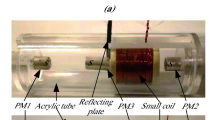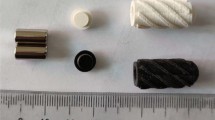Abstract
In this paper, a self contained capsubot (capsule robot) propulsion mechanism is investigated. The proposed capsubot works on the principle of internal force-static friction. A modified linear DC motor is used to drive the capsubot. A novel acceleration profile is proposed for the moving part (linear cylinder) based on the principle. A significant feature of the proposed capsubot is that it is legless, wheelless, and trackless. The developed capsubot with a proposed propulsion mechanism demonstrates a very good average velocity. The propulsion mechanism has the potential to be used for the propulsion of a wireless-controlled self-propelling capsule endoscope. Simulation and experimental results demonstrate the performance of the self-contained capsubot with the proposed acceleration profile.
Similar content being viewed by others
References
Y. Kusuda. A further step beyond wireless capsule endoscopy. Sensor Review, vol. 25, no. 4, pp. 259–260, 2005.
G. Iddan, G. Meron, A. Glukhovsky, P. Swain. Wireless capsule endoscopy. Nature, vol. 405, no. 6785, pp. 417, 2000.
A. Moglia, A. Menciassi, P. Dario, A. Cuschieri. Capsule endoscopy: Progress update and challenges ahead. Nature Reviews Gastroenterology and Hepatology, vol. 6, no. 6, pp. 353–361, 2009.
S. Park, J. Park, H. Park, S. Park, C. Jee, S. Park, B. Kim. Multi-functional capsule endoscope for gastrointestinal tract. In Proceedings of SICE-ICASE International Joint Conference, IEEE, Busan, Korea, pp. 2090–2093, 2006.
B. Kim, S. Park, J. Park. Microrobots for a capsule endoscope. In Proceedings of IEEE/ASME International Conference on Advanced Intelligent Mechatronics, IEEE, pp. 729–734, 2009.
H. Park, S. Park, E. Yoon, B. Kim, J. Park, S. Park. Paddling based microrobot for capsule endoscopes. In Proceedings of IEEE International Conference on Robotics and Automation, IEEE, pp. 3377–3382, 2007.
H. Y. Li, K. Furuta, F. L. Chernousko. Motion generation of the capsubot using internal force and static friction. In Proceedings of the 45th IEEE Conference on Decision and Control, IEEE, pp. 6575–6580, 2006.
G. Kosa, P. Jakab, F. Jolesz, N. Hata. Swimming capsule endoscope using static and RF magnetic field of MRI for propulsion. In Proceedings of IEEE International Conference on Robotics and Automation, IEEE, pp. 2922–2927, 2008.
M. E. Rentschler, J. Dumpert, S. R. Platt, K. Lagnernma, D. Oleynikov, S. M. Farritor. Modeling, analysis, and experimental study of in vivo wheeled robotic mobility. IEEE Transactions on Robotics, vol. 22, no. 2, pp. 308–321, 2006.
Y. Liu, M. Hasan, H. Yu. Modelling and remote control of an excavator. International Journal of Automation and Computing, vol. 7, no. 3, pp. 349–358, 2010.
S. Gorini, M. Quirini, A. Menciassi, G. Pernorio, C. Stefanini, P. Dario. A novel SMA-based actuator for a legged endoscopic capsule. In Proceedings of the 1st IEEE/RASEMBS International Conference on Biomedical Robotics and Biomechatronics, IEEE, Pisa, Italy, pp. 443–449, 2006.
J. Suthakorn, S. Shah, S. Jantarajit, W. Onprasert, W. Saensupo, S. Saeung, S. Nakdhamabhorn, V. Sa-Ing, S. Reaungamornrat. On the design and development of a rough terrain robot for rescue missions. In Proceedings of IEEE International Conference on Robotics and Biomimetics, IEEE, Bangkok, Thailand, pp. 1830–1835, 2009.
Y. H. Zweiri. Identification schemes for unmanned excavator arm parameters. International Journal of Automation and Computing, vol. 5, no. 2, pp. 185–192, 2008.
M. Eich, F. Grimminger, F. Kirchner. Proprioceptive control of a hybrid legged-wheeled robot. In Proceedings of IEEE International Conference on Robotics and Biomimetics, IEEE, Bangkok, Thailand, pp. 774–779, 2009.
M. Simi, P. Valdastri, C. Quaglia, A. Menciassi, P. Dario. Design, fabrication, and testing of a capsule with hybrid locomotion for gastrointestinal tract exploration. IEEE/ASME Transactions on Mechatronics, vol. 15, no. 2, pp. 170–180, 2010.
M. Suzuki, S. Kitai, S. Hirose. Basic systematic experiments and new type child unit of anchor climber: Swarm type wall climbing robot system. In Proceedings of IEEE International Conference on Robotics and Automation, IEEE, Pasadena, USA, pp. 3034–3039, 2008.
P. Glass, E. Cheung, M. Sitti. A legged anchoring mechanism for capsule endoscopes using micropatterned adhesives. IEEE Transactions on Biomedical Engineering, vol. 55, no. 12, pp. 2759–2767, 2008.
P. Glass, E. Cheung, H. Wang, R. Appasamy, M. Sitti. A motorized anchoring mechanism for a tethered capsule robot using fibrillar adhesives for interventions in the esophagus. In Proceedings of the 2nd IEEE RAS & EMBS International Conference on Biomedical Robotics and Biomechatronics, IEEE, pp. 758–764, 2008.
M. Quirini, S. Scapellato, P. Valdastri, A. Menciassi, P. Dario. An approach to capsular endoscopy with active motion. In Proceedings of the 29th Annual International Conference of IEEE Engineering in Medicine and Biology Society, IEEE, Lyon, France, pp. 2827–2830, 2007.
A. Menciassi, P. Valdastri, C. Quaglia, E. Buselli, P. Dario. Wireless steering mechanism with magnetic actuation for an endoscopic capsule. In Proceedings of Annual International Conference of IEEE Engineering in Medicine and Biology Society, IEEE, Minneapolis, USA, pp. 1204–1207, 2009.
F. Carpi, C. Pappone. Magnetic maneuvering of endoscopic capsules by means of a robotic navigation system. IEEE Transactions on Biomedical Engineering, vol. 56, no. 5, pp. 1482–1490, 2009.
M. Nokata, S. Kitamura, T. Nakagi, T. Inubushi, S. Morikawa. Capsule type medical robot with magnetic drive in abdominal cavity. In Proceedings of the 2nd IEEE RAS & EMBS International Conference on Biomedical Robotics and Biomechatronics, IEEE, pp. 348–353, 2009.
H. Yu, Y. Liu, T. Yang. Closed-loop tracking control of a pendulum-driven cart-pole underactuated system. Journal of Systems and Control Engineering, vol. 222, no. 2, pp. 109–125, 2008.
Y. Liu, H. Yu, T. Yang. Analysis and control of a capsubot. In Proceedings of the 17th IFAC World Congress, IFAC, Korea, vol. 17, pp. 756–761, 2008.
M. N. Huda. Analysis and Control of Propulsion Systems to be Integrated with Wireless Capsule Endoscopy, Master dissertation, Faculty of Computing, Engineering and Technology, Staffordshire University, UK, 2010.
FAULHABER, [Online], Available: http://www.faulhabergroup.com/, June 6, 2011.
Ansmann Racing, [Online], Available: http://www.ansmannracing.com/, June 6, 2011.
H. Olsson, K. Astrom, C. Canudas de Wit, M. Gafvert, P. Lischinsky. Friction models and friction compensation. European Journal of Control, vol. 4, no. 3, pp. 176–195, 1998.
Author information
Authors and Affiliations
Corresponding author
Additional information
This work was supported by EPSRC funded UK-Japan Network on Human Adaptive Mechatronics Project (No. EP/E025250/1) and EU Erasmus Mundus Project-eLINK (No.EM ECW-ref.149674-EM-1-2008-1-UK-ERAMUNDUS)
M. Nazmul Huda received the B. Sc. degree in electrical and electronic engineering from Bangladesh University of Engineering and Technology, Bangladesh in 2008 and MRes in robotics and control systems from Staffordshire University, UK in 2011. He is currently a Ph.D. candidate in robotics and control systems at Staffordshire University. He worked as a lecturer in the Department of Electrical and Electronic Engineering at Ahsanullah University of Science and Technology (AUST) in Bangladesh.
His research interests include robotics for medical applications, nanorobotics, and biomedical signal processing.
Hong-Nian Yu is currently a professor of computer science at Staffordshire University, UK. He has held several research grants worth about three million pounds from EPSRC, the Royal Society, and the EU, AWM, as well as from the industry. He has successfully completed an EU funded Asia-Link project (Euro-Asia Collaborations and Networking in Information Engineering System Technology) and currently is supervising two EU projects (East-west Link for Innovation, Networking and Knowledge exchange, 5.5 million Euro) and (Sustainable E-Tourism, 2.5 million Euro). He was the general chair of International Conference on Software Knowledge Information Management and Applications (SKIMA) in 2006, and is serving on various other conferences and academic societies.
His researches interests include wireless networked control systems, radio frequency identification (RFID) and its applications, mobile computing, modelling, scheduling, planning, and simulations of large discrete event dynamic systems with applications to manufacturing systems, supply chains, transportation networks, and computer networks.
Samuel Oliver Wane received the master degree in electronic engineering from the University of Hull, UK in 1996. He went on to develop software for the “Handy-1”, a rehabilitation robot to aid people with no arms to feed themselves. His improvements to the robot allowed it to shave, wash, brush teeth, and play games. He then spent two years designing and developing biscuit packing robots for the food industry. Since 2000, he has been working as a senior lecturer in robotics and control at Staffordshire University, UK and a part-time Ph.D. candidate where he is developing a wirelessly controlled robot propulsion mechanism as part of the Mobile Computing and Distributed Systems (MCDS) Team.
Rights and permissions
About this article
Cite this article
Huda, M.N., Yu, HN. & Wane, S.O. Self-contained capsubot propulsion mechanism. Int. J. Autom. Comput. 8, 348–356 (2011). https://doi.org/10.1007/s11633-011-0591-3
Received:
Revised:
Published:
Issue Date:
DOI: https://doi.org/10.1007/s11633-011-0591-3




